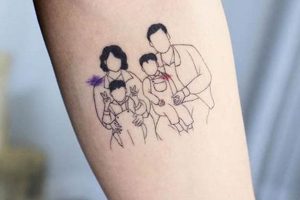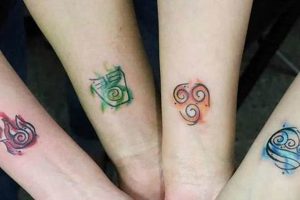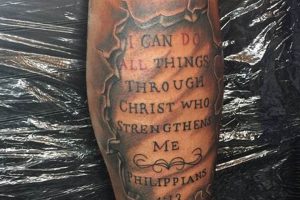Permanent body art depicting loved ones offers a powerful way to honor familial bonds. Representations range from realistic portraits in black and grey or full color to more symbolic imagery such as birth flowers, important dates, or shared objects of significance. Examples include a classic portrait of children, a stylized rendering of the family pet, or a minimalist outline of the family home.
Choosing this type of permanent artwork can be a deeply personal and meaningful act. It serves as a constant reminder of connection, love, and shared history, effectively carrying cherished memories close. While portraiture has a long and rich history across art forms, its application in tattooing has gained significant popularity in recent decades, reflecting a growing desire for highly individualized and expressive body art.
Key considerations for those exploring this avenue of expression include artistic style, placement on the body, size, and the skill level of the chosen tattoo artist. Understanding these factors is crucial for achieving a result that is both aesthetically pleasing and emotionally resonant.
Tips for Family Portrait Tattoos
Careful planning is essential for a successful and meaningful family portrait tattoo. These tips offer guidance through the process, from concept to execution.
Tip 1: Style Selection: Consider various artistic styles, from photorealism to abstract or illustrative. Research different tattoo artists specializing in these styles to find a suitable match.
Tip 2: Reference Quality: Provide the tattoo artist with clear, high-resolution photographs for the portrait. Blurry or low-quality images can compromise the final result.
Tip 3: Placement and Size: Think carefully about the desired size and location on the body. Larger portraits offer greater detail, while smaller designs might be more discreet. Body contours should also be considered.
Tip 4: Artist Consultation: Discuss ideas and expectations with the chosen artist thoroughly. A collaborative approach ensures a shared understanding of the desired outcome.
Tip 5: Color vs. Black and Grey: Evaluate the impact of color versus black and grey. Color can add vibrancy and realism, while black and grey can create a classic, timeless feel.
Tip 6: Symbolic Elements: Consider incorporating symbolic elements, such as birthdates, names, or objects, to personalize the design further.
Tip 7: Budget Considerations: High-quality, detailed portrait tattoos can be time-consuming and expensive. Establish a budget early in the planning process.
Following these guidelines can significantly contribute to a well-executed, cherished piece of body art that honors family connections for years to come.
By carefully considering these factors, individuals can ensure a meaningful and aesthetically pleasing outcome.
1. Style (realism, abstract)
Artistic style significantly impacts the overall aesthetic and emotional resonance of a family portrait tattoo. Choosing between realism, abstract, or other styles requires careful consideration of personal preferences and desired representation of family members.
- Realism
Realistic portraits aim for accurate depictions of individuals, capturing likeness and details through shading, line work, and color gradients. This style evokes a strong sense of presence and emphasizes individual characteristics. Examples include highly detailed portraits resembling photographs, capturing specific facial features and expressions. Realism necessitates larger canvases and skilled artists capable of intricate detail work.
- Abstract
Abstract styles prioritize symbolic representation over literal depiction. Family members might be represented through shapes, colors, or shared motifs, emphasizing emotional connection rather than physical likeness. Examples include interwoven lines representing family bonds or stylized silhouettes capturing essential forms. Abstract designs offer greater flexibility in size and placement, and can be more forgiving if subtle changes occur over time.
- Illustrative
Illustrative styles borrow elements from various art forms, such as graphic novels, traditional painting, or animation. This approach allows for greater creative freedom, incorporating bold lines, vibrant colors, and exaggerated features. Examples include portraits rendered in a comic book style or with a watercolor effect. Illustrative tattoos often convey a specific mood or narrative, adding a layer of symbolic meaning.
- Watercolor
Watercolor tattoos mimic the fluid and translucent qualities of watercolor paintings. This style creates a soft, dreamlike aesthetic, emphasizing color blending and organic shapes. While portraits can be incorporated, this style often lends itself to more abstract or floral elements, complementing or enhancing realistic elements within a larger family-themed design.
The chosen style profoundly influences the final aesthetic of the tattoo and its perceived meaning. Selecting a style that aligns with individual artistic sensibilities and the desired message ensures a timeless and personally resonant tribute to family bonds.
2. Placement (arm, back, chest)
Placement significantly influences the visual impact and personal meaning of a family portrait tattoo. The body area chosen interacts with the design’s size, style, and the wearer’s lifestyle. Consideration of body contours, visibility preferences, and potential changes due to aging or weight fluctuations is crucial.
The back offers a large, relatively flat canvas suitable for detailed, expansive compositions. A sprawling family tree or a collection of individual portraits can effectively utilize this space. The chest provides a space close to the heart, appropriate for intimate portraits of immediate family members. Arms offer versatile options: the upper arm accommodates medium-sized designs, while the forearm allows for smaller, more readily visible portraits. Placement decisions should reflect the desired level of privacy and the overall aesthetic balance of the tattoo in relation to the body.
Practical considerations influence placement choices. Individuals in professions with dress codes might opt for less visible locations. Areas exposed to sunlight require greater attention to aftercare and sun protection to maintain color vibrancy. Understanding the interplay between placement, design, and lifestyle ensures a family portrait tattoo remains aesthetically pleasing and personally meaningful over time.
3. Size (small, large)
Size plays a critical role in the design and execution of family portrait tattoos, directly impacting detail, placement options, and overall aesthetic. Careful consideration of size ensures the chosen design effectively conveys the intended message and remains visually appealing over time.
- Small-Scale Portraits
Smaller portraits offer subtlety and discretion, often placed on the wrist, ankle, or behind the ear. These designs typically focus on simplified representations, silhouettes, or symbolic elements rather than intricate details. Small portraits suit minimalist aesthetics or individuals seeking a less conspicuous tribute.
- Medium-Scale Portraits
Medium-sized portraits allow for a greater level of detail while maintaining placement flexibility. Suitable for the forearm, calf, or shoulder blade, these designs can incorporate more intricate line work and shading, allowing for recognizable likenesses or the inclusion of background elements.
- Large-Scale Portraits
Large-scale portraits provide ample space for detailed depictions of multiple family members or complex compositions. The back, chest, or thigh offer suitable canvases for these expansive designs, allowing for realistic renderings, intricate backgrounds, and the incorporation of symbolic elements.
- Proportion and Balance
Regardless of size, proportion and balance within the design are crucial. Elements within the portrait should harmonize with each other and the chosen placement on the body. A skilled tattoo artist can guide size decisions, ensuring the desired level of detail is achievable and aesthetically balanced within the chosen space.
Size considerations are integral to the planning process. Balancing desired detail, placement limitations, and overall aesthetic goals ensures a family portrait tattoo that remains visually impactful and personally meaningful throughout its lifetime.
4. Color palette (vibrant, muted)
Color palettes significantly influence the mood, aesthetic, and longevity of family portrait tattoos. Careful selection of hues contributes to the overall impact of the design, conveying desired emotions and ensuring visual harmony. Color choices should complement skin tone, chosen style, and the intended message of the portrait.
- Vibrant Palettes
Vibrant color palettes utilize saturated hues to create bold, eye-catching designs. This approach can effectively convey joy, energy, and celebration, lending a dynamic quality to the portrait. Bright primary colors or a spectrum of jewel tones might represent a family’s lively spirit. However, vibrant colors can fade more quickly than muted tones, requiring touch-ups over time.
- Muted Palettes
Muted color palettes employ desaturated hues, creating a softer, more understated aesthetic. This approach can evoke a sense of nostalgia, tranquility, or timeless elegance. Pastel shades or a range of earth tones might represent a family’s close bond and shared history. Muted colors tend to age more gracefully, requiring less frequent touch-ups.
- Black and Grey Realism
Black and grey palettes focus on tonal variations to create depth, dimension, and realistic depictions. This classic approach emphasizes detail and shading, allowing for nuanced expressions and lifelike representations of family members. Black and grey portraits offer a timeless quality and tend to hold their definition well over time.
- Color Realism
Realistic portraits utilizing a full-color palette can capture the true likeness of individuals, including skin tones, eye color, and hair color. This approach requires a skilled artist capable of blending and layering colors to achieve a lifelike effect. Color realism offers a vibrant and personalized representation but may require more frequent touch-ups compared to black and grey.
Color palette choices profoundly affect the final aesthetic and emotional impact of a family portrait tattoo. Selecting a palette that aligns with individual preferences, skin tone, and the intended message ensures a visually harmonious and personally meaningful result that endures over time. Consulting with a skilled tattoo artist allows for informed decisions regarding color selection and its long-term impact on the design.
5. Composition (individuals, group)
Compositional choices significantly impact the narrative and emotional resonance of family portrait tattoos. Whether depicting individuals separately or as a group, the arrangement of subjects, inclusion of background elements, and overall visual flow contribute to the tattoo’s storytelling capacity. Compositional decisions should reflect the intended message and the relationships being honored.
Individual portraits offer opportunities to highlight each family member’s unique personality and characteristics. Separate portraits might be arranged in a series, connected by a unifying element such as a shared background or symbolic motif. This approach allows for stylistic variations within the overall theme, reflecting individual preferences while maintaining a cohesive narrative. For example, individual birth flowers could accompany each portrait, adding a layer of personal symbolism.
Group portraits emphasize the collective bond and shared history of the family. Posing, proximity, and interaction between figures convey the dynamics of relationships. A family grouped closely together suggests intimacy and connection, while individual portraits interwoven within a larger design might represent a family tree or interconnectedness across generations. A group portrait of children playing together captures a specific moment in time and emphasizes their shared experiences. Background elements, such as a family home or a significant location, can further enhance the narrative and emotional depth of the composition.
Successful compositions create a visual balance and guide the viewer’s eye through the narrative. Strategic placement of elements, use of negative space, and interplay between light and shadow contribute to a cohesive and engaging design. Understanding compositional principles allows for effective storytelling within the constraints of the chosen canvas, whether it’s a small wrist tattoo or a large-scale back piece. Effective composition elevates a family portrait tattoo beyond mere representation, transforming it into a powerful and enduring expression of familial love and connection.
6. Personalization (names, dates)
Personalization through the inclusion of names, dates, and other symbolic elements elevates family portrait tattoos beyond visual representation, imbuing them with deeper meaning and individual significance. These additions transform the tattoo into a personal narrative, commemorating specific milestones, relationships, and shared experiences. The careful selection and integration of these elements enhance the emotional resonance and storytelling capacity of the design.
Names serve as anchors, explicitly linking the portrait to specific family members. Incorporating full names, initials, or nicknames adds a layer of intimacy and recognition. Birthdates, anniversary dates, or dates of other significant events further contextualize the portrait, commemorating shared history and milestones within the family narrative. These temporal markers anchor the tattoo in time, serving as permanent reminders of cherished moments. Beyond names and dates, symbolic elements such as shared hobbies, meaningful objects, or quotes can further personalize the design. A musical note might represent a shared love of music, while a specific flower might symbolize a cherished memory or individual personality trait. These additions create a rich tapestry of personal meaning, weaving individual stories into the larger family narrative.
The placement and style of these personalizing elements contribute to the overall aesthetic and impact of the tattoo. Names might be subtly integrated into the background, forming part of a decorative border or flowing along the contours of the portrait. Dates can be rendered in elegant script, Roman numerals, or other stylistic choices that complement the overall design. The careful integration of these elements ensures they enhance rather than detract from the central portrait. Consideration of scale, font, and placement ensures visual harmony and readability. A skilled tattoo artist can guide these decisions, ensuring personalized elements are seamlessly integrated into the overall composition. Ultimately, personalization transforms a family portrait tattoo into a powerful and enduring testament to familial love, shared history, and individual connection.
7. Artist selection (portfolio, experience)
Selecting a qualified artist is paramount for realizing successful family portrait tattoos. A skilled artist translates cherished memories and emotional connections into enduring works of art. Thorough research and careful consideration of an artist’s portfolio and experience are crucial for achieving desired results. The chosen artist’s technical skills, artistic style, and understanding of portraiture significantly impact the final product’s quality and longevity.
- Portfolio Examination
A comprehensive portfolio review provides insights into an artist’s technical abilities, stylistic preferences, and experience with portraiture. Closely examine the line work, shading, color blending, and composition in previous works. Look for consistency in quality and evidence of the artist’s ability to capture likeness and convey emotion. A portfolio specializing in the desired style, whether realism, abstract, or illustrative, indicates a higher likelihood of achieving desired results. Assess the artist’s handling of skin tones, textures, and details, especially if seeking a realistic portrait. A strong portfolio demonstrates an artist’s mastery of technical skills and artistic vision.
- Experience and Specialization
Experience in portrait tattooing is essential for capturing the nuances of human likeness and emotion. Inquire about the artist’s specific experience with portraiture, including the number of years dedicated to this specialization and any relevant training or certifications. An experienced portrait artist possesses a deep understanding of facial anatomy, proportions, and the technical challenges of translating photographic references onto skin. Specialized training in portraiture demonstrates a commitment to refining skills and staying abreast of industry best practices.
- Consultation and Communication
Effective communication between the client and artist is crucial for a successful outcome. A thorough consultation allows for a collaborative exchange of ideas, expectations, and concerns. A skilled artist actively listens to the client’s vision, offers guidance on design choices, and addresses any questions or apprehensions. Open communication fosters a shared understanding of the desired outcome, ensuring the final tattoo aligns with the client’s emotional and aesthetic goals. A collaborative approach minimizes potential misunderstandings and contributes to a positive and fulfilling tattooing experience.
- Hygiene and Professionalism
Maintaining high hygiene standards is critical in tattooing. A reputable artist adheres to strict sterilization protocols, utilizes single-use needles, and maintains a clean and organized workspace. Inquire about the artist’s hygiene practices and observe the studio environment during the consultation. Professionalism encompasses not only technical skill but also ethical conduct, respectful communication, and a commitment to client safety and satisfaction. Choosing a professional and hygienic artist ensures a safe and positive tattooing experience.
Selecting a skilled and experienced artist is a crucial investment in the quality and longevity of a family portrait tattoo. Thorough research, portfolio review, and open communication ensure the chosen artist possesses the technical expertise and artistic vision to transform cherished memories into enduring works of art. The right artist becomes a partner in the creative process, guiding design choices and ensuring the final tattoo reflects the unique story and emotional connection of the family being honored.
Frequently Asked Questions
Addressing common inquiries regarding permanent representations of loved ones in body art provides clarity and facilitates informed decision-making.
Question 1: How much do family portrait tattoos typically cost?
Pricing depends on factors such as size, complexity, artist’s skill level, and geographic location. Larger, more detailed portraits require more time and expertise, resulting in higher costs. Researching artists and obtaining quotes are essential for budgeting.
Question 2: How long do family portrait tattoos take to complete?
Completion time varies depending on size, complexity, and the artist’s working speed. Smaller, simpler designs might take a few hours, while larger, more intricate portraits can require multiple sessions spanning several weeks or months.
Question 3: What are the best placement options for family portrait tattoos?
Optimal placement depends on individual preferences, design size, and lifestyle considerations. The back and chest offer larger canvases for detailed portraits, while arms and legs provide options for smaller or more readily visible designs. Body contours and potential changes due to aging or weight fluctuations should also be considered.
Question 4: How painful are family portrait tattoos?
Pain levels vary depending on individual pain tolerance, placement on the body, and the tattooing process. Areas with thinner skin or closer to bone tend to be more sensitive. Consultations allow discussions regarding pain management techniques and expectations.
Question 5: How should one care for a family portrait tattoo after it’s completed?
Proper aftercare is crucial for healing and preserving the vibrancy of a new tattoo. Following the artist’s specific aftercare instructions is essential. General guidelines include keeping the tattoo clean, moisturized, and protected from sun exposure during the healing process.
Question 6: Can family portrait tattoos be modified or covered up later?
Modifications or cover-ups are possible, but depend on the original design, size, and color palette. Consultations with experienced artists are recommended to discuss options and limitations. Laser removal is also a possibility but can be a more complex and costly process.
Careful consideration of these frequently asked questions facilitates informed decisions and contributes to positive outcomes. Thorough research, open communication with artists, and realistic expectations are crucial for achieving satisfying and meaningful family portrait tattoos.
For further information or specific inquiries, consulting with a qualified tattoo artist is recommended.
Family Portrait Tattoo Ideas
Exploration of permanent familial portraiture reveals its capacity to serve as a profound expression of love, connection, and shared history. Careful consideration of stylistic choices, placement, size, color palettes, composition, personalization options, and artist selection are critical for achieving desired results. Understanding these factors ensures a visually compelling and emotionally resonant final product.
Permanent body art offers a powerful medium for commemorating familial bonds. Thoughtful planning and collaboration with skilled artists transform personal narratives into enduring tributes, preserving cherished memories for generations to come. The decision to embark on this artistic journey represents a commitment to honoring family connections in a deeply personal and permanent manner.







